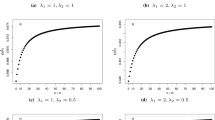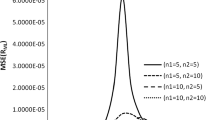Abstract
In this paper, a likelihood based analysis is developed and applied to obtain confidence intervals and p values for the stress-strength reliability R = P(X < Y) with right truncated exponentially distributed data. The proposed method is based on theory given in Fraser et al. (Biometrika 86:249–264, 1999) which involves implicit but appropriate conditioning and marginalization. Monte Carlo simulations are used to illustrate the accuracy of the proposed method.
Similar content being viewed by others
References
Al-Hussanini E, Mousa M, Sultar K (1997) Parametric and nonparametric estimation of P(Y < X) for finite mixtures of log-normal components. Commun Stat Theory Methods 26:1269–1289
Awad A, Azzam M, Hamdan M (1981) Some inference results on P(Y < X) in the bivariate model. Commun Stat Theory Methods 10:2515–2525
Barndorff-Nielsen OE (1986). Inference on full and partial parameters, based on the standardized signed log-likelihood ratio– Biometrika 73:307–322
Barndorff-Nielsen OE (1991) Modified signed log-likelihood ratio– Biometrika 78:557–563
Cox DR, Hinkley DV (1974) Theoretical statistics–Chapman and Hall, London
Doganaksoy N, Schmee J (1993) Comparisons of approximate confidence intervals for distributions used in life-data analysis. Technometrics 35:175–184
Downton F (1973) The estimation of P(Y < X). in the normal case– Technometrics 15:551–558
Enis P, Geisser S (1971) Estimation of the probability that Y < X– J Am Stat Assoc 66:162–168
Fraser DAS, Reid N (1995) Ancillaries and third order significance– Utilitas Math 7:33–55
Fraser DAS, Reid N, Wu J (1999) A simple general formula for tail probabilities for frequentist and Bayesian infernce– Biometrika 86:249–264
Helperin M, Gilbert P, Lachin J (1987) Distribution-free confidence intervals for P(X 1 < X 2). Biometrics 43:71–80
Hamdy M (1995) Distribution-free confidence intervals for P(X < Y) based on independent samples of X and Y. Commun Stat Simulation Comput 24:1005–1017
Reid N (1996) Likelihood and higher-order approximations to tail areas: a review and annotated bibliography. Can J Stat 24:141–166
Severeni T (2000) Likelihood methods in statistics. Oxford University Press, New York
Tong H (1974) A note on the estimation of P(Y < X) in the exponential case. Technometrics 16:625
Tong H (1975) Letter to the editor. Technometrics 17:393
Wong ACM, Wu J (2000) Practical small-sample asymptotics for distributions used in life-data analysis. Technometrics 42:149–155
Woodward W, Kelly G (1977) Minimum variance unbiased estimation of P(Y < X) in the normal case. Technometrics 19:95–98
Author information
Authors and Affiliations
Corresponding author
Rights and permissions
About this article
Cite this article
Jiang, L., Wong, A.C.M. A note on inference for P(X < Y) for right truncated exponentially distributed data. Stat Papers 49, 637–651 (2008). https://doi.org/10.1007/s00362-006-0034-3
Received:
Revised:
Published:
Issue Date:
DOI: https://doi.org/10.1007/s00362-006-0034-3




